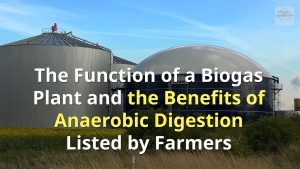Answering the question of the function of biogas plants. Many people new to the industry would say that the true function of a Biogas Plant is surely simply to make biogas… Full stop! end of discussion.
And yet, this would be at odds with the long list of other AD Plant benefits invariably listed by real farmers who have their own on-farm anaerobic digestion facilities.

We have found that farmers appreciate the benefits of on-farm biogas production, but their experience of their own anaerobic digestion plants reveals many other benefits.
It is with that in mind that we were fascinated to read the Royal Agricultural Society of England report authored by Angela Bywater, titled: “A Review of Anaerobic Digestion Plants on UK Farms – Barriers, Benefits and Case Studies”, which is available on their website as a pdf download. This article, and the embedded video, were written by us to highlight just one small part of this report which talks about the real-life experiences of real farmers while using their biogas plants.
We have reproduced part of the executive summary below, but we suggest that you watch our video below first as an introduction to this subject, and afterwards return and SCROLL DOWN for the full content of our article:
Structure and Function of Biogas Plants.
“All of the farmers involved in the case studies in a Royal Agricultural Society of England study lauded the numerous benefits of AD which included:
• improved slurry handling;
• the ability to target crop nutrients;
• increased nutrient uptake;
• increased spreading windows;
• less crop taint and decreased re-grazing times;
• significant odour reduction when compared with slurries;
• a reduced or nil reliance on fossil-fuel-based fertilisers;
• reduced reliance on fossil fuel-derived heat;
• a vastly decreased potential for watercourse pollution;
• fewer emissions to air (odour, ammonia and GHGs);
• environmentally friendly farm diversification.
In other words, on-farm anaerobic digestion offers a significant step towards more sustainable farming.
It is for these reasons that the UK Government and the agriculture industry see anaerobic digestion as the ideal way to treat slurry. As stated in DEFRA’s Shared Vision for Anaerobic Digestion, the NFU would like to see 1000 on-farm digesters by
2020.
Work done by the RASE and AEA Group indicates that for the greatest impact, low-cost AD plants should be targeted at dairy farms, starting from about 100 cows and upwards.“
Anaerobic digestion is able to address waste, energy, sustainable food production, and nutrient recycling challenges in a sustainable and circular manner. It does this by connecting and closing the loop on previously linear processes of sending organic waste to landfills.
Source: The above excerpt is from: “A Review of Anaerobic Digestion Plants on UK Farms – Barriers, Benefits and Case Studies“; Supporting Sustainable Agriculture, By Angela Bywater, Royal Agricultural Society of England – Executive Summary.
 When government subsidies such as the FiT (Feed-in Tariff) Scheme for England were first introduced there was a great deal of disappointment that small farm AD plants were, at the last minute, omitted from the subsidy. There was a huge disappointment when the lowest band of subsidy eligibility was set just above the rate of power generation small farms could achieve.
When government subsidies such as the FiT (Feed-in Tariff) Scheme for England were first introduced there was a great deal of disappointment that small farm AD plants were, at the last minute, omitted from the subsidy. There was a huge disappointment when the lowest band of subsidy eligibility was set just above the rate of power generation small farms could achieve.

It is not known why such a great opportunity to assist small farm businesses was passed over. It was done by Defra without much comment and even less warning. It was only apparent when the regulation's small-print was issued. It truly was a wasted opportunity.
Perhaps one day in the UK, money will be paid by the nation for the benefits the farmers with AD plants provide toward the environment and the long term sustainability of farming.
In other words an investment in the future health of farming. A way in which marginal farms can diversify, raise their income and improve the financial security of their businesses. This might mean that they would not need assistance from the national purse in the form of welfare payments to low-earners (income supplements), and other benefits for the poor.
Other Function of Biogas Plant References Online:
Biogas Defined and the Function of AD Systems from Wikipedia
Biogas typically refers to a mixture of different gases produced by the breakdown of organic matter in the absence of oxygen. Biogas can be produced from raw materials such as agricultural waste, manure, municipal waste, plant material, sewage, green waste or food waste. Biogas is a renewable energy source.
Biogas can be produced by anaerobic digestion with anaerobic organisms, which digest material inside a closed system, or fermentation of biodegradable materials.
Biogas is primarily methane (CH4) and carbon dioxide (CO2) and may have small amounts of hydrogen sulfide (H2S), moisture and siloxanes. The gases methane, hydrogen, and carbon monoxide (CO) can be combusted or oxidized with oxygen.
This energy release allows biogas to be used as a fuel; it can be used for any heating purpose, such as cooking. It can also be used in a gas engine to convert the energy in the gas into electricity and heat. via Biogas – Wikipedia
The microscopic organisms that produce biogas, known as Archaea, are among the oldest life forms on Earth. Much less oxygen-breathing and CO2-absorbing plant life.
The Function of Biogas Plant Operation in Principle
In airtight fermentation vessels – the so-called digesters – use a function of biogas plant operation, namely a fermentation process.
This is stimulated and produces biogas using bacteria. The bacteria are similar to those which can also be found in the digestive tract of a cow.
The main products of anaerobic degradation are energy-rich methane and CO2. Since both are gaseous, they separate from the fermentation substrate and form the main components of biogas.
Carbon dioxide is not oxidised, but then can be supplied together with the energy-rich methane cogeneration power stations of methane combustion and fed into each locally existing heat network. via EnviTec Biogas AG
The Function of a Food Waste Biogas Plant Operation shall be to control the digester's chemical environment as follows:
4. pH of the digester: Neutral pH is an important parameter in anaerobic digestion, just as it is for aerobic composting. If pH is measured at the inlet, it will be slightly lower than neutral — usually, around 5.5 — as fresh material is converted into acids.
The pH will neutralise as these acids are converted into methane gas. By the time the liquid bio-fertilizer comes out of the digester, it should be pH 7.
If the pH of the bio-fertiliser is lower than this, it is an indicator the digester has been over-fed and is at risk to “sour,” or stop working due to low pH.
If the pH at the inlet goes below 5.5, it is necessary to add some wood ashes or lime to buffer the biogas plants digester.
A function of biogas plant operation is to prevent a “soured digester” from developing which has no bubbling activity and instead of producing gas, it draws air into it.
The top will be sucked in tightly against the surface of the liquid and if a brewer’s airlock is being used, the water in the airlock will be sucked into the digester.
Restarting a soured digester is time-consuming, severely compromising the function of the biogas plant affected, and in most cases, it is simpler to dump it out and start over.
5. Feedstock: Biogas production is best at the 25:1 C:N ratio as aerobic composting.
Cattle manure is the most common feedstock for biogas because cattle manure is naturally the perfect 25:1 carbon-to-nitrogen ratio. Cattle manure makes an excellent feedstock to begin
The above factors are controlled by digester loading.
After these five steps, it is important to know that for the first 48 hours for a small digester or up to a couple of weeks for a larger system, the digester will only produce carbon dioxide (CO2).
Carbon dioxide is of course used in fire extinguishers. Biogas is a ‘green' sustainable energy vector that plays an important role in transitioning to a low-carbon society.
When you put a match to the gas to test for flammability, it will be blown out with an audible “hiss” and a wisp of black smoke.
As the biogas begins to come on, the hiss and black smoke will be gone and you will smell the distinct “rotten eggs” scent of the hydrogen sulfide (H2S).
This odour is the signal to begin capturing your gas, as it is either flammable or soon will be.
The prolonged “CO2 Phase” has caused many people to abandon projects, that might have been successful in producing a flammable gas renewable energy if they had waited a short time longer. via Structure and purpose of AD plants CO2
Biogas
Biogas is an amalgamation of gases mainly containing methane and carbon dioxide that is produced by raw materials e.g. agricultural residue, manufactories, municipal waste plants, sewage and other materials.
The fuel is renewable energy. Biogas is obtained by anaerobic digestion using anaerobic organisms or methanogens within anaerobic digestion, biodigestion or bioreactors.
Biogas is mostly methane (CH4 ) and carbon dioxide ( CO ) and contains a little amount of hydrogen sulfide, H2S, moisture and siloxane.
Working of a Modern Biogas Plant
Biogas plants are decentralized energy systems that enable energy efficiency and reduce environmental pollution while providing heat and electricity supply.
A biogas plant stabilizes organic waste by natural biological procedures with little or no atmosphere and converts waste to biogas or biofertiliser.
The facility is suitable for wet organic material and is commonly used for the treatment of biodegradable material.
Modern biogas plants include waste collection anaerobic digested effluent processing plants storage tanks for gases. Plus CHP and other renewable energy generating devices.
What are biogas plants and how do they work?
Biogas can be produced from a wide range of waste materials, including animal manure, municipal trash/waste, plant material, food waste, and sewage.
In terms of biogas, it's difficult not to talk about biogas plants because they're basically the places in which biogas is produced.
Biogas plants can help create a low carbon emission environment by producing biogas through fermentation. A huge range of sizes is offered and serve as carbon-neutral energy. Biogas plants work to reduce the greenhouse effect and the amount of harmful gases in the atmosphere by capturing methane emissions.
Is the Biogas Plant the answer to the Circular economy?
Sourcing biogas plant fuel is the best solution to solving a two-dimensional global environmental problem: increasing waste and rapid decarbonisation. Power technologies examine biogas's pros and cons.
The mode of operation of biogas plants is a key differentiator. The fermentation process can be wet or dry, depending on the substrate.
Wet fermentation is always used for organic waste substrates with high liquid content, such as manure. For stackable organic biomass such as municipal biowaste, dry or solid-state fermentation biogas plants are used.
[ Article posted originally from England on 21 Feb 2018.]








I enjoyed the cartoon. Give us more jokes, but keep it clean. good site.
hi could you please give me a rough picture of the cost of setting up of a plant and what would be the out put of it ?
Check out the Green Power Network website to find out if there is a green power alternative available in your area. Consider switching to green power if there is a good service available in your area and if you can afford to. You might be able to get a tax rebate in some states.
can you redo this without such gawd awful noise on the video? horrible